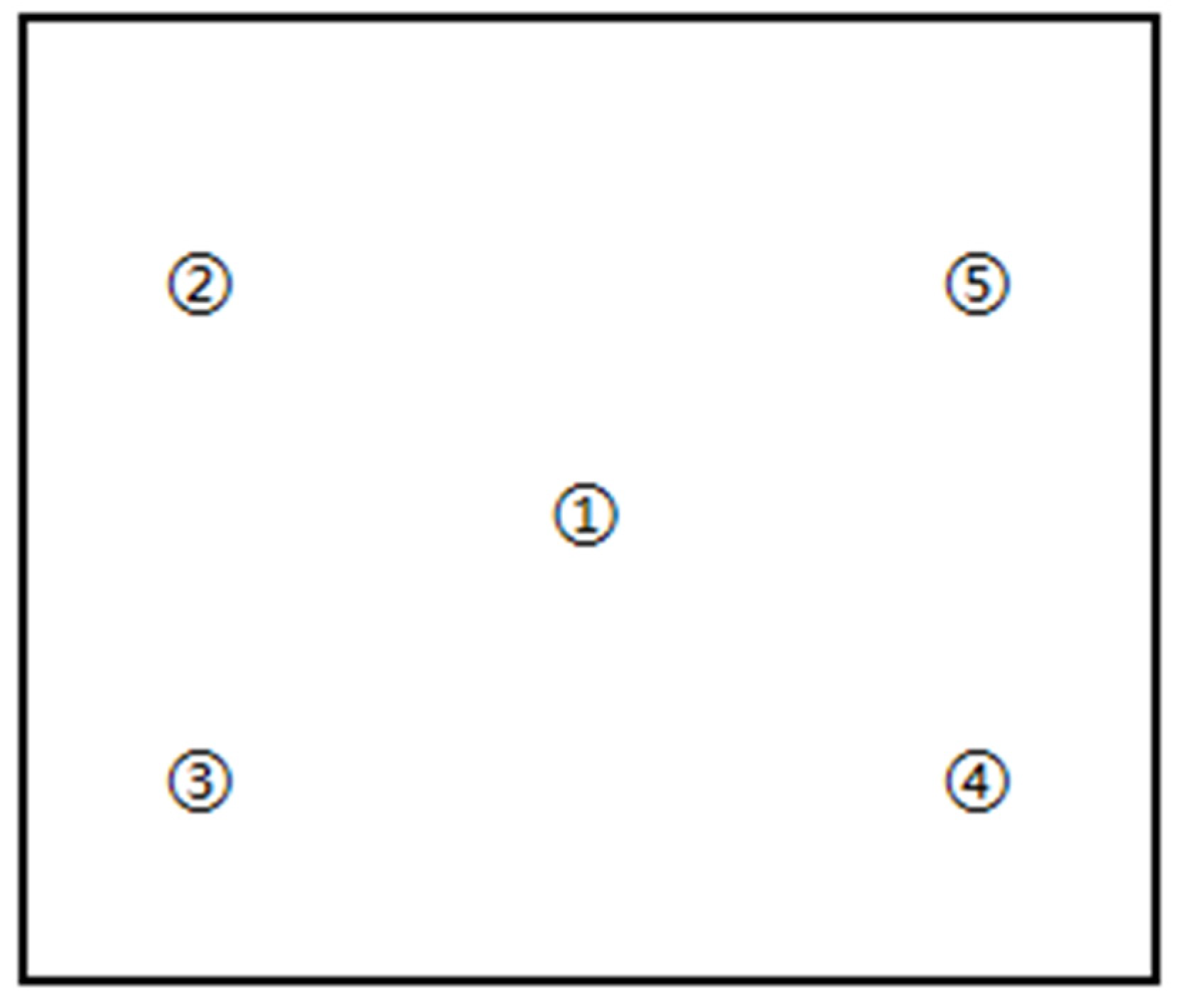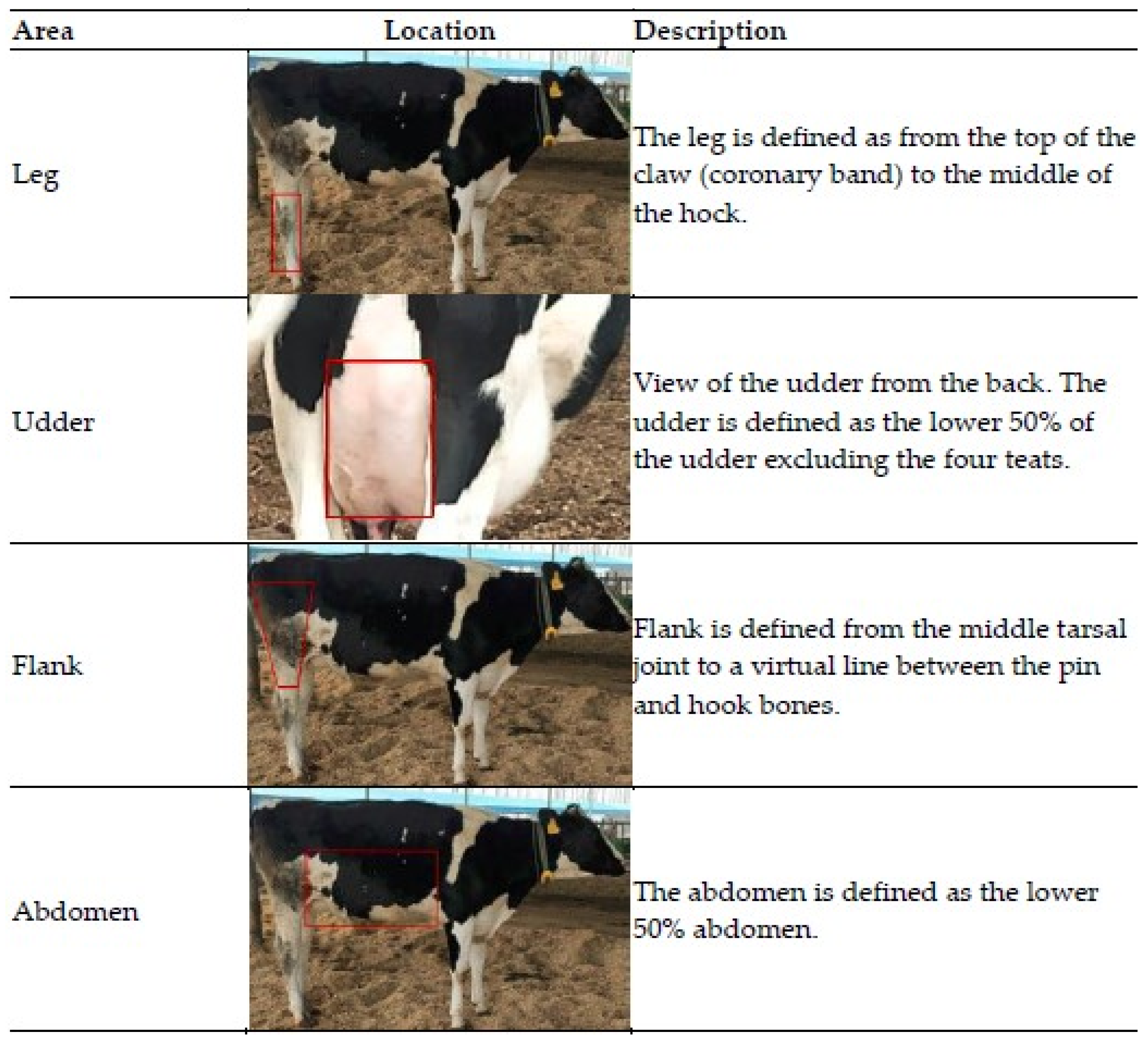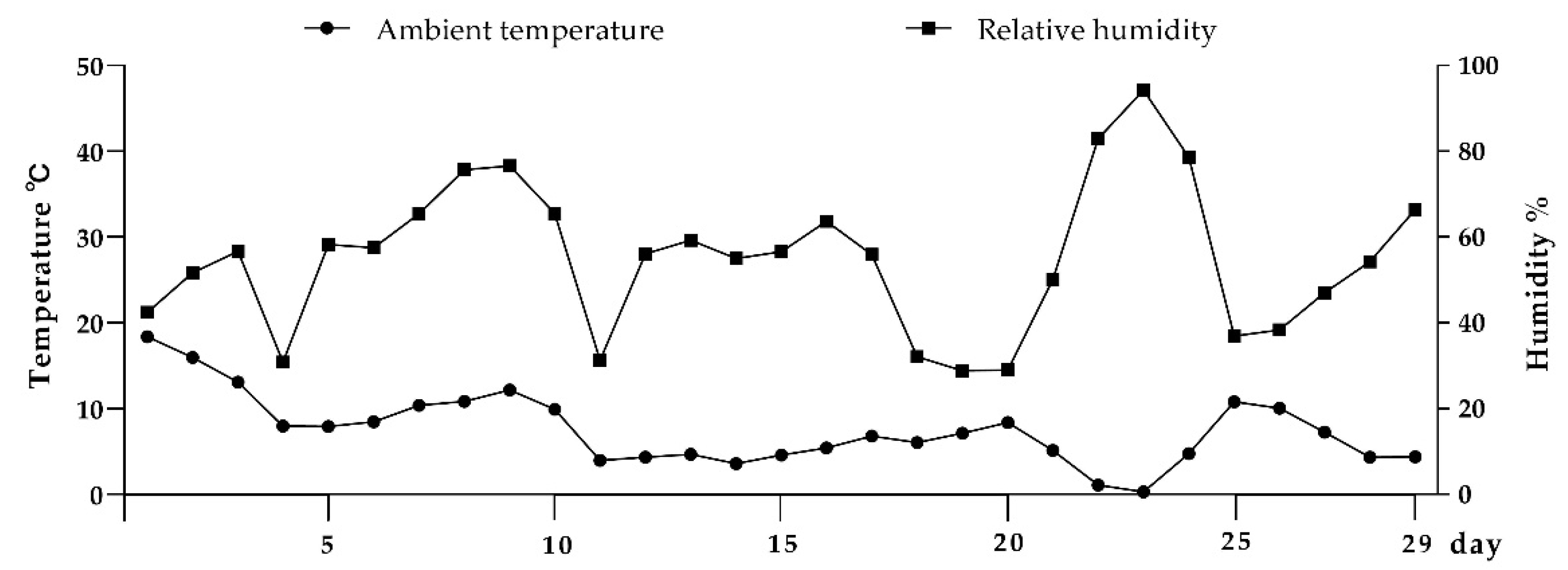1. Introduction
Lying down is essential in the daily activities of dairy cows. The duration of time that cows normally spend lying down is between 8 and 16 h each day [
1]. Adequate rest is essential for the health and welfare of dairy cows [
2]. When cows are deprived of rest, growth hormone and milk yield are reduced [
3]. Duration is not the only factor involved in determining the adequacy of rest; the quality of rest is also important and is influenced by bedding characteristics such as the amount, type, and moisture [
1,
4,
5]. Usually, deep, dry, and clean bedding materials are preferred by cows and can improve the welfare of dairy cows [
1,
5]. The provision of comfortable bedding can improve the health, welfare, and productivity of dairy cows [
6,
7,
8]. The most common types of bedding used in free-stall barns are sand, sawdust, wheat straw, and wood shavings [
9]. Nevertheless, it is generally accepted that organic bedding material, such as straw, is favoured by cows over nonorganic materials, such as sand, and that cows lie for longer when offered organic material [
4,
10,
11]. The dry period is a crucial stage in the dairy cow lactation cycle that affects both health and performance after calving [
12]. Good facilities for cows during their dry period can promote udder health and increase milk yield in the next lactation [
13,
14]. Cow lying time after parturition may be linked to health status; for example, ketosis is associated with increased lying time [
15]. Consequently, it is very important that dairy cows are carefully monitored and that their environment provides sufficient opportunities for good health and welfare [
16].
Rice husk has been used as a bedding material in commercial farms [
17], although it has only been tested experimentally for lambs and pigs [
18,
19,
20]. As far as we know, no studies of its suitability for dairy cows have been published, and information on cow preference, health, welfare, and cost would be valuable. In central China, only a small amount of rice is grown, and importation of husks from neighbouring rice-growing regions has a high transportation cost because of its bulk, resulting in a need for alternative bedding materials. Henan grows large quantities of peanuts, with about 1.7 million tons of peanut husks are produced yearly (Henan Academy of Agricultural Sciences Portal;
http://www.hnagri.org.cn/, accessed on 5 April 2021). The broken peanut shells are dry and soft, characteristics usually favoured by cows for increased comfort [
1,
5,
21]. Peanut shells also have low amounts of bacteria and moisture, which make them suitable for deep bedding systems [
22,
23]. Hence, peanut shells provide a potential bedding material for dairy cows in this region.
Scientific studies of dairy cow bedding usually record cow behaviour (e.g., lying, standing, eating and drinking, etc.), body hygiene (particularly of the udder and legs), and health (which may be determined from serum metabolites) [
5,
15,
24]. We explored the characteristics and effects of peanut shells and rice husk in two experiments. In the first, we compared the preference of nonlactating dairy cows for peanut shells, rice husks, or a combination of the two. We examined the physical characteristics of the bedding materials and the influence of ambient weather conditions. In the second experiment, we evaluated the behaviour, cleanliness, serum metabolites, and production of cows provided with the same three bedding treatments.
4. Discussion
The goal of this study was to compare the preference of dairy cows for three bedding materials and to determine the effects of different bedding on animal behaviour, welfare, and health. During the period when cows had a free choice of three bedding types, cows lied down most often and spent more time lying down on rice husk than on peanut shells and peanut–rice combinations (
Table 4), while the average lying time per bout did not differ between the three bedding materials. The lying time, the number of lying bouts, and the mean lying time of cows have been considered indicators of cow preference in previous studies [
4,
5,
26]. The results from the cow behaviour in the current study indicated that rice husk is a preferred bedding material. Cows prefer to spend more time lying down on comfortable, soft, and dry bedding surfaces [
21,
27]. Wolfe et al. [
26] determined that cows spend more time on deep-bedded switchgrass, compared to a combination of switchgrass, water, and lime, because it had the advantage of being softer and drier. Therefore, the properties of bedding materials appear to affect the preference of dairy cows. In the current study, the dry matter content of all three bedding types was higher than 80%, but no differences were detected between bedding materials with a similar dry matter. Organic bedding material with high moisture typically has higher bacterial loads, compared to inorganic material [
27,
28], and cows prefer to lie down on dry bedding surfaces (DM: 44% vs. 23% and 89.8% vs. 34.7%) [
4,
21]. In other words, wet bedding damages the welfare of dairy cows by affecting resting time.
On the other hand, the heat distribution of the bedding was elucidated by thermal images when the cows were lying down (
Table 3), indirectly reflecting the heat loss of the bedding during resting. In this study, there were no differences in the mean temperature of the thermal images between bedding materials in each pen. For surface temperature, there was no difference between bedding types when compared at the same time. Panivivat et al. [
29] found that bedding of wheat straw had higher surface temperatures than rice husk and wood shavings between the months of August and October (summer to autumn in Tennessee, Argentina). However, in the current study, cold ambient temperatures did not cause surface temperature differences to change the preference of cows, which differed from our expectation that the cows would make bedding choices based on the surface temperature of bedding. Therefore, in this research, it appeared that the soft and comfortable nature of rice husk was favoured by the dairy cows.
In Experiment 2, cows were only given one of three potential bedding types. Cow behaviour was unaffected by the type of bedding material presented (
Table 5). There were no statistical differences found for any behaviour in response to bedding type. This is in contrast with Experiment 1 in which the cows showed a clear preference for rice husk bedding with longer lying times and more lying bouts, in comparison to peanut shell and peanut–rice combination, when given access to all three types of bedding. This contradiction has also been found in previous studies. Cows have shown a preference for deep-bedded switchgrass and straw bedding over rubber matting when given access to all options, but there was no difference in total lying time when they were only given one of the multiple potential bedding options [
26,
30]. This suggests that although cows may show a preference for specific bedding materials, it does not always prevent them from resting when faced with only one bedding choice.
Cows tended to spend the most resting time on rice husk and the least time in the peanut–rice combination, but these differences were not significant. This aligns with the number of lying bouts, which was most frequent for the rice husk bedding, followed by peanut shell and the peanut–rice combination (
Table 5). In the current study, the total lying time, number of lying bouts and mean duration of lying bouts of cows on the peanut–rice combination and peanut shell fell into the reported normal range of 9.5 to 12.9 h/d, 7 to 10 bouts/d, and 65 to 112 min reported by two previous studies: Ito et al. [
31] and Piñeiro et al. [
15]. Tucker et al. [
2] reported that the lying time of lactating cows is 8 to 13 h/d. Kaufman et al. [
32] found that the mean lying time of 10.5 h/d for primiparous cows and 12.3 h/d for multiparous cows at 7 dbp, which is similar to the mean lying time of 11.7 h/d at 10 dbp reported by Huzzey et al. [
33]. On the other hand, Solano [
34] and Wolfe et al. [
26] reported the lying time of lactating cows as 10.4 h/d for straw, 10.6 h/d for sawdust, 10.5 h/d for wood shavings, and 9.9 h/d for switchgrass. In this experiment, the mean lying time was observed to be 10.8 to 14.2 h/d before parturition, regardless of bedding treatments, but no differences were found between the bedding types. However, according to Llonch et al. [
24], the daily lying time of dry cows (15.5 h/d) on compost-type bedding was longer than ours. This difference may be attributed to the depth of materials, activity area, and housing system [
1,
2].
Feed intake is related to animal energy balance [
35]. Bedding treatments did not affect the amount of time that cows spent eating or drinking in Experiment 2 of the current study. Beauchemin [
36] reported the eating time of lactating cows to be from 2.4 to 8.5 h/d. Hut [
37] and Llonch et al. [
24] reported the eating time of dry cows to be 5.8 h/d and 2.8 h/d, respectively. Eating times in the current study are largely similar to the published literature, ranging from 4.5 h/d (rice husk bedding) to 5.7 h/d (peanut–rice combination). For drinking time, our results were also in line with the published report (6 min/d) by Llonch et al. [
24] in cold weather. Our results indicate that time spent eating and drinking was within the normal range of previous literature. Therefore, the different bedding types assessed in this study still result in normal amounts of eating and drinking behaviour, which is positive for welfare and health.
Cow cleanliness was measured using a Likert scale from 1 (free of dirt) to 4 (very dirty). The cleanliness of cows was not affected by different bedding treatments. Greater improvement in the cleanliness of flanks was found for those cows in post-test than in pre-test, while the udder cleanliness score increased over the study (
Table 6). It is well known that as hygiene improves, milk quality also increases and clinical mastitis decreases [
38,
39,
40], and cow cleanliness can be affected by bedding materials and environmental management [
4,
41]. In the current study, no differences in cleanliness were found between bedding types, which is in line with the reports by Panivivat [
29] and Wolfe et al. [
26], who compared cows on different bedding materials.
Adequate energetic balance is important for maintaining both cow welfare and adequate production levels. Serum BHB and NEFA concentrations are used as indicators of energy balance and hyperketonemia in cows [
42,
43]. Ketosis can be diagnosed by a BHB serum concentration of ≥1.2 mmol/L [
32,
44]. According to Piñeiro et al. [
15], the voluntary lying time of cows before calving has a positive quadratic relationship with the NEFA concentration. In the current study, bedding type did not affect the mean BHB and NEFA serum concentrations of the dairy cows (
Table 7). Mean BHB and NEFA serum values were within a normal reference range [
32,
44,
45]. Cows suffering from subclinical hypocalcaemia have a higher risk of the displaced abomasum, ketosis, retained placenta, and a higher risk of being culled [
46,
47]. Furthermore, in severe cases of hypocalcaemia, parturient paresis may develop in dairy cows. According to Reinhardt et al. [
48], hypocalcaemia can be defined when total serum calcium concentrations are less than 2.0 mmol/L (8.0 mg/dL) within the first two days after calving. Previous research indicates the prevalence of hypocalcaemia in multiparous cows is higher than for primiparous cows [
15,
49], which is similar to the finding observed in the current study, that is, the serum calcium concentration of multiparous cows was lower than that of primiparous cows. Milk yield is negatively correlated with lying time [
50]. Normocalcemic multiparous cows produce more milk than hypocalcaemia cows, but no association has been found between the lying time of multiparous cows and hypocalcaemia before calving [
46,
51]. Therefore, it may be expected that milk yield and calf weight could differ between the three bedding treatments, which may be the reason why no significant differences were found between treatments, i.e., because of the lack of difference in lying time. Mean serum concentrations were all within the normal range, suggesting that all three bedding materials are suitable for the welfare and health of dairy cows.














